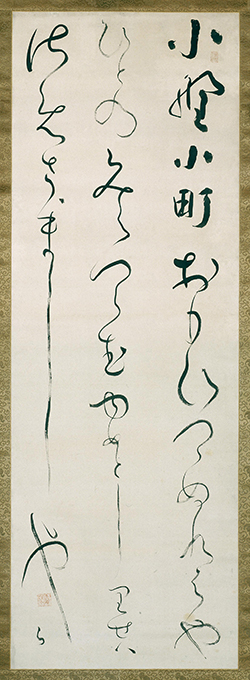Poetry as Visual Art: Iko no Taiga
I’ve written before in this blog about my fascination with LINE, one of the Elements of Art. I’ve pointed out that when it comes to calligraphy, line is not only defining the shapes of a work of art: it is the work of art. When one thinks about it, calligraphy actually represents the merging of two art forms: painting and writing.
So, there you have it, I’m a sucker for calligraphy, from any culture. One of my favorites is cursive Japanese. It’s so elegant, simple and graceful. Can you think of any art movement in the West where the simple writing of words has been displayed as a work of art? The only thing that comes to my mind is Conceptual Art of the 1960s and 1970s, though, compared to this Taiga scroll, simple western type-face on a piece of paper doesn’t quite match up in visual excitement.
 |
| Iko no Taiga (1723–1776, Japan), Calligraphy of a poem by Ono no Komashi (800s), ca. 1770. Ink on paper mounted as a hanging scroll, 55 ¾" x 22 ¾" (141.6 x 57.9 cm). © Philadelphia Museum of Art. (PMA-2946) |
Taiga was born in Kyoto. His father worked at a silver mint but died when Taiga was three. Somehow, his widowed mother managed to afford good teachers in all the classical Japanese and Chinese disciplines. At the age of six, he began receiving instruction in calligraphy at the Mampuku-ji Zen temple, a place with which he would have strong connections the rest of his life. By the age of fourteen, Taiga was a professional artist and distinguished calligrapher.
Taiga is most renowned for his landscape painting, and for being one of the leading painters of the Japanese bunjin (literati) “school.” The literati painters, through their landscapes, expressed the simple pleasures of communing with nature. Like their Chinese counterparts, the bunjin painters often accompanied their paintings with poems of their own inspiration. Certainly, one of the most influential of Japanese poets at the time was the ninth century Ono no Komachi.
Ono no Komachi is considered one of the Immortals of Poetry as early as the early 1000s CE, which is estimated to have been only a couple hundred years after her death. She is widely considered to be one of the first major women poets in the history of the world, and her poetry was widely quoted in Japanese literature. During the Edo period (1615–1867), it was fashionable for great beauties to have themselves immortalized in Ukiyo-e prints as incarnations of the poet.
All of Ono no Komachi’s poems are in the five-line tanka form, almost the only pattern used in Japanese poetry until the haiku became established 800 years later, by dropping the last two lines of the tanka. This scroll is written in Japanese cursive script called sosho. The poem reads:
Was it that I fell asleep
Longing for him
That he appeared?
Had I known it was a dream
I should not have awakened.


Comments